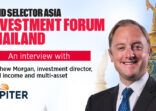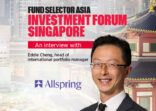Terry, tell me about your new job role, which has expanded following the departure of Jamal Saab as head of Middle East and North Africa?
Terry Mellish: I am formally the business development unit head, for MENA, as I am for Ireland and UK institutional, so I combine those two roles. The fact that I’m not domiciled in the Middle East isn’t an issue because we have a team in Dubai that’s substantially stronger than we’ve ever had before.
My boss, Hervé Guinamant, is NGAM’s international CEO for distribution. He’s based in Paris.
I joined NGAM in January 2010 to develop the UK institutional business, which at the time had about $4.5bn or $5bn of assets under management. Now it has over $12bn, so that’s fantastic growth. We’ve managed to very successfully diversify our business by an increasing number of affiliates and, therefore, an increasing number of solutions, strategies and products.
The asset growth we’ve seen in the Middle East has been tremendous over the past 18 months or so.
A lot of our business is institutional around the world and, increasingly, we face up to the global investment consultants, such as Russell Investments. Those firms are encroaching into what we will call retail or other distribution channels as well. So they’re advising, or they’re providing their research to private banks, to wealth management firms and so on.
To have a strategy and an approach that addresses some of those issues is my responsibility. I also cover what we do in Africa. We don’t have a presence there yet but we do have clients in Africa.
Moad, what are your responsibilities?
Moad Touhami: My responsibility is to build our wholesale distribution business out of the UAE and across the GCC. Clearly a lot of the financial advisers in the region will be accessing the NGAM funds through the life insurance platforms here.
We’ve done a lot of work to leverage off of some great relationships. Myself and my team have to get our message to more people, to let them know about our different investment managers. We have well over 20 investment managers based around the world, from Boston in the US to Mumbai in India.
Which geographical markets do you operate in?
TM: The attraction for a lot of the affiliates in joining the NGAM stable is that we have a global distribution capability. We have opened up offices in five new markets over the past two or three years.
Asia is a growing sphere of influence to us. In Asia, we’ve just surpassed our record for assets under management, we’ve done the same in Europe where we’ve opened up a number of offices, and if you look at the UK, the staff numbers have gone from sub-20 to approaching 50 over the past four years. That’s a significant success story. We’ve had record sales this year, globally. Positive sales, therefore, in each of the last
10 years as a firm, at the same time as increasing our net resource year on year.
MT: Our potential target area is MENA, so it’s the Middle East and North Africa as well, which could potentially include Morocco, Egypt, Tunisia and Libya.
Realistically, how we’ve looked to develop the wholesale distribution is, first of all, by developing, building, and supporting our relationships in the UAE, which has by far the largest amount of international wealth management firms operating out of it. All of the global private banks and large international life companies are present here as well. Our first focus was to make sure that we were building and cementing those relationships.
Outside of that, we looked at other countries within the GCC which had robust, well understood, regulatory environments. That’s not to say that we wouldn’t look at other areas in time. So, we do understand that there is potential in places like Saudi Arabia and Kuwait.
North Africa is interesting but, obviously, over the past couple of years there have been some challenges from a geopolitical point of view. It’s certainly something that we would explore in the future if we saw potential.
Another area which we’re in the early stages of looking at – and I think some of our competitors may begin to look at it in time – is Turkey, which has similar dynamics to other areas that we cover, with its large and growing middle class. We’re not doing anything there on the ground yet, but it’s a country that’s on the radar.
For me, the key focus for 2013 was cementing the existing relationships we had with the UAE, Bahrain and Qatar and making sure that we supported them as well as we could.
Another big focus this year was the recognition that we can’t just be fund manufacturers, which is why we conducted two quite large international surveys, with a big Middle East element, to understand what our investors’ behaviours are.
We got some amazing results out of it to show that investors are desperate for advice. They’re generally underadvised in the region. 70% of investors we asked don’t have a financial adviser, and they’re looking to take risks. With this information we have been able to work with financial advisers in the region to, in turn, think about how best to approach those types of investors to service them.
This meant that Saudi Arabia and Kuwait are two markets that we’ve put on the backburner for now, but we’ll certainly look to explore again in the future.
TM: It’s important to stress the institutional channel is clearly a different channel in the sense that we target a lot of the sovereign wealth funds and central banks – a far smaller prospective client base, but bigger sums of money.
What we’ve been able to do on the back of delivering some great solutions into the institutional space is to drive more into some of the same markets on the distribution side.
Using our ‘durable portfolio’, we have constructed a philosophy to enable us to promote a greater number of affiliates and their solutions to clients. So, ‘durable portfolio construction’ is our global philosophy. It’s not a marketing message. It just enables us to have an in-depth discussion with clients, or prospective clients, about the key drivers to build more durable portfolios from a risk and reward perspective for many years to come. So that philosophy has been the driver to our business in all regions, including the Middle East.
MT: Financial advisory groups have gone through a real learning process over the past few years. So, whereas five or six years ago a diversified portfolio might be a client having 60% in equities and 40% in bonds, and ‘off we go’, now everybody has a better understanding that it can’t be as simple as that.
We sit down with advisers and look at their model portfolios to get an understanding of where some of the potential risks are and try to make sure they have been constructed in the way that they were intended.
Name some of your most popular funds and any underlying investment trends.
MT: We’ve spoken to some of the non-resident Indian advisers in the region, who in turn advised non-Indian resident clients, and what we felt was there was a real demand for an Indian fund that was actually operating trueout of India as a genuine Indian business.
As a result of that, we went out and partnered up with an investment manager called IDFC, an asset management company based out of India, and we took a stake in that company. We launched the fund in the region, which we’ve taken some really good assets in, and we’ve provided a solution the region was looking for.
One thing we’ve consistently seen as the largest challenge for advisers in the region, and they often say it to me, is the risk mentality of investors based in the Middle East, including international investors who live and work here. We have to make sure that we are giving advisers access to several different asset classes and investment managers.
In 2012, there was quite a large trend of investing in fixed income and we had the solution for that. We have a fantastic manager of both fixed income and equity, based out of Boston, called Loomis Sayles. They’re very experienced managers, and we had a great product there which was a multi sector, fixed income type product.
Last year it has continued to perform relatively well and take in money but we’ve seen this risk trend where suddenly equities have come massively into favour. That’s where Harris Global Equity is a pretty popular fund in the region, with a high conviction manager based out of Chicago.
There is always something in the region creating a hurdle rate for you. Last year it was Indian-denominated, short maturity plans, which were offering 10% to 11%. That has faded away, and this year over the past few months it is probably real estate.
TM: Despite the fact we had more than 20 affiliates, there are nonetheless a small number who are very popular in markets generally around the world such as Loomis Sayles and Harris Associates. Increasingly we are also seeing some of the Natixis Asset Management structures doing very well in places like Europe and in Asia.
We’re very conscious there are some things that we can benefit clients with in terms of funds and platform structures, which we want to do, market by market. Having more products registered on different platforms around the world, from a distribution perspective, is an increasing requirement for us, as well as the channels we operate in.
















